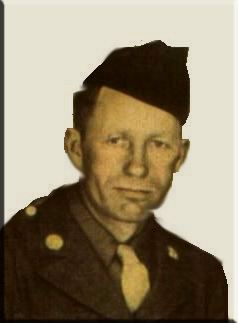
Bill Gray's Story ...
On 7 December 1941, Japan bombed Pearl Harbor. Americans were really mad about that! Enlistment centers were overwhelmed by the flood of eager enlistees. Bill Gray's old friend, Slim, tried to talk Bill into joining the Sea Bees with him when it looked like war was imminent, but Bill had a wife and family, and so decided to wait and see if the draft would want him.
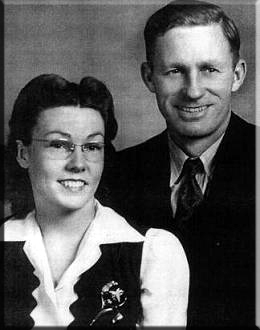 Bill and his wife Arline
Bill and his wife ArlineBill and Arline had been married six years when he finally received his draft notice on 14 January 1944. They had a little daughter named Gloria who was four years old and a baby son, Robert, who was only two month old.
 Bill's wife Arline, daughter Gloria and baby Robert
Bill's wife Arline, daughter Gloria and baby RobertInitially, the draft inducted only single men. Eventually, however, the rise in wartime casualties led to the drafting of married men and fathers. As a result, a total of 944,426 fathers were drafted. 400,000 American fighting men died in WWII, leaving behind 183,000 orphaned children.
Bill was first sent to Camp Fannin, Texas for basic training. Camp Fannin was an infantry replacement training center. Bill expected to be there for an extended period so he sent for his wife and family to join him.
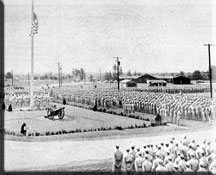
Camp Fannin, Texas in WWII
The trip to Texas was unbelievably difficult for Arline due to many car breakdowns, flat tires and the rationing that was in effect because of the war. Both gasoline and car tires were in short supply and difficult to obtain. The very day that Arline and kids arrived at Camp Fannin, Bill had received notice that he was to ship out for Europe. He had about two weeks with his little family.
Bill became a replacement infantryman destined for the fighting in Europe. That is to say, he would be replacing those who had gone before him, into Normandy on D-Day, and had been killed.

The D-Day landings, 6 June 1944
Bill arrived in France on 27 August 1944. He was assigned to Patton's Third Army, 28th Infantry Division, 109th Infantry Regiment, Company E, along with fifteen other men.
On 28 August 1944, the men of Company E marched fifteen miles, entrucked and rode another fifteen miles. Their destination - an assembly area outside Paris, where they were to join the rest of the 28th Division for a march through the recently liberated city.
109th Infantry Regiment of the 28th Infantry Division
in France in the fall of 1944
On the morning of 29 August 1944, Company E was trucked another twenty miles in the rain. They were fed and proceeded to make preparations for the parade. Troops were issued clean uniforms to the extent possible. In the meantime, the rain ceased and a warm sun shone.
Within the 109th Regiment, the men of 2nd Battalion, to which Bill was assigned, along with the 1st Battalion, were to march side by side in the lead, a total of twenty-four men abreast onto the Champs Elysee, splitting into two columns around the Arc de Triomphe, where a reviewing stand for dignitaries had been erected. The troops were reviewed by Generals Omar Bradley, Courtney Hodges, Norman Cota, and French General Charles de Gaulle, among others. The parade took approximately four hours and was impeded by thousands upon thousands of French people who jammed the spacious sidewalks to overflowing, leaned from every window and doorway, all smiling, waving, shouting, and in every way telling the American troops that they were delighted to see them.
 The 28th Infantry Division marching through Paris
The 28th Infantry Division marching through ParisChamps Elysees, 29 August 1944
At midnight orders were received to move out the next day with all possible speed after the retreating Germans. The days ahead brought more rain and chilly weather and marching, anywhere from two miles to nineteen miles a day, pursuing the fleeing Germans, but somewhere along the way, Bill found time to write a hastily scribbled letter home to his wife. It would be the first, last and only letter she received from him.
On 1 September, the 109th Regiment began a tactical road march which continued until it reached the German-Luxembourg border eleven days later and 195 miles away. On 11 September the Regiment faced the Siegfried Line, known to the Germans as the "West Wall," the western border of Germany!
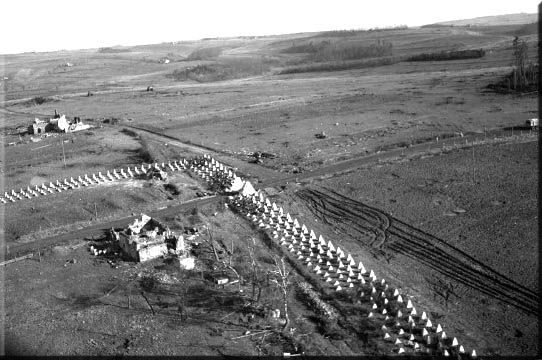 The Siegfried Line or West Wall
The Siegfried Line or West WallThe 109th Regiment was directed to probe for any weakness in the Wall until sufficient ammunition and fuel arrived to launch full-scale attacks against the enemy in his homeland. They were among the first Allied forces to probe the German frontier.
Near the small town of Sevenig, the soldiers came under intense artillery, mortar and small-arms fire and began to take casualties. The next day they continued north toward the town of Harspelt.
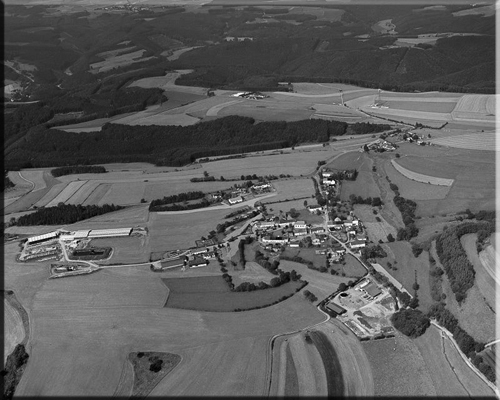 The area around Harspelt (G) where Bill Gray was killed
The area around Harspelt (G) where Bill Gray was killedOn 14 September 1944, it was raining. Enemy fire was increasingly intense, resulting in heavy casualties. Private William George Gray was one of those casualties. Cause of death - fragments in his back, most probably as a result of a mortar shell.
He had suffered the fate of so many replacement soldiers who, like Bill, had been rushed through training, sent to replacement camps and into battle, where they died because of combat inexperience and went right back to the rear on the route by which they had come. Bill had been in Europe two weeks.
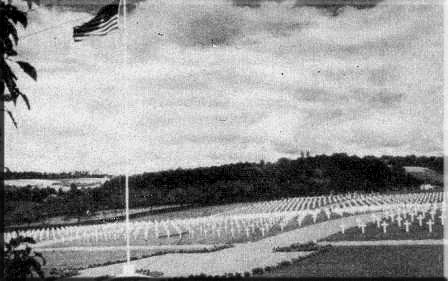 Temporary American Military cemetery in Fosse, Belgium
Temporary American Military cemetery in Fosse, BelgiumBill was buried near where he fell, in a temporary cemetery at Fosse, Belgium. Later his remains were moved to a permanent location at the Henri-Chapelle American Military Cemetery. Beside him lay almost 8000 comrades. His remains occupy Plot F, Row 16, Grave 18.
 PVT William G Gray's final resting place
PVT William G Gray's final resting placeThree months later, Bill's comrades of Company E, now located at Fuhren, were over-run by German troops and tanks in what would be called the Battle of the Bulge. Those who survived would be marched off to prison camps for the remainder of the war.
In 2002, a young Belgian couple adopted Bill's grave. They visit regularly, bringing prayers and flowers and their gratitude to his peaceful resting place. They send pictures to Bill's family, who miss their dear, brave father and will never, never, ever forget his great sacrifice.
Special thanks to Bill Gray's daughter Gloria Haslam and to Régine Villers